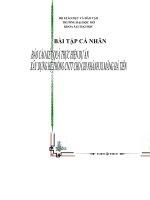Dự án xây dựng hệ thống giao thông thông minh tại đường cao tốc hải PHòng
Bạn đang xem bản rút gọn của tài liệu. Xem và tải ngay bản đầy đủ của tài liệu tại đây (2.13 MB, 23 trang )
THE PROJECT OF BUILDING THE INTELLIGENT TRANSPORTATION
SYSTEM - DEVELOPING THE TRAFFIC MANAGEMENT SYSTEM (TMS) FOR
HANOI - HAIPHONG HIGHWAY
1. INTRODUCTION
1.1 Introduction of Vietnam Infrastructure Development and Finance Investment Joint
Stock Corporation (VIDIFI for short)
Vietnam Infrastructure Development and Finance Investment Joint Stock Corporation
(VIDIFI for short), had a charter capital of 5,000 billion VND. The founding shareholders
included: Vietnam Development Bank (VDB), Saigon Invest Group (SGI), Joint Stock
Commercial Bank for Foreign Trade of Vietnam (Vietcombank), Vietnam Construction and
Import – Export Joint Stock Corporation (Vinaconex).
In the decision No. 1621/QD-TTg on 29/11/2007 on some mechanisms and policies for the
pilot investment project of Hanoi – Hai Phong Highway, the Prime Minister has assigned
VIDIFI as the investor of high speed motorway project in Hanoi - Hai Phong under the
form of BOT contract.
VIDIFI is the investor of Hanoi – Hai Phong highway project and projects of building the
infrastructure for urban areas, industrial parks, services and logistics areas in sync with these
two projects. Besides, VIDIFI will invest in the financial, securities, real estate sectors and
other effective projects to recover investment capital for building projects. The founding
shareholders gain VIDIFI remarkable advantages in terms of capital, financial, securities
and real estate investment as well as mobilizing and attracting domestic and foreign
investment capital.
Strategic objectives:
Focus on constructing the Hanoi - Hai Phong Highway Project to ensure its
progress and quality. Building the harmonious infrastructure for industrial
parks, urban, and services areas ...) to enhance the potential of the nearby
regions and contribute to recovering the capital invested in Hanoi – Hai Phong
high speed highway.
Promote the investment in financial, securities, real estate sectors and in other
projects, in order to fully exploit the benefits from shareholders.
Develop strategic collaborative relationships with domestic and international
economic corporations and financial organizations.
VIDIFI is a noble corporation with a large scale, great financial potential,
remarkable efforts to improve business constantly and develop durably as well
as qualified and capable staff. The corporation’s activities are professional. Its
organizational structure is minimal. Management ability is enhanced
following modern tendencies and the financial state is apparent and public,
which aims at the market and international integration.
Below is a route map of the Ha Noi – Hai Phong. Highway
1.2 Objectives of the traffic management system TMS project
Promote utilizing and operating the highway better by charging tolls and
traffic controlling services, improve convenience and organize user data by
constructing and installing necessary equipment for toll collecting and traffic
control on Hanoi - Hai Phong highway.
In order to gain benefits from road toll collecting and improve convenience
for passengers, the equipment will be reviewed and selected for Hanoi - Hai
Phong highway.
The scope of this project is drawing a directly controlled area of main
roads and intersections of Hanoi - Hai Phong Highway that have equipment
installed at the scene. Designing standards will be applied and referring from
which of South Korea and America...
2. CONTENT OF THE REASEARCH
2.1 Overview of the traffic management system (TMS) project
TMS is a traffic management system used to collect and transmit information via closed
circuit television camera (CCTV) and vehicle detection system (VDS), synthesize and
analyze traffic situations at Traffic Information Center as well as provide real time traffic
information via variable message sign (VMS), internet, mobile phone and radio.
Configuration of TMS information network at Hanoi - Hai Phong Highway
Figure 2.1: Configuration of information network
2.2 Details of traffic management system (TMS)
Information management of TMS is divided into three steps: collecting, processing and
servicing:
a) Information collecting system
Traffic information is collected via vehicle detection system (VDS) and CCTV.
Information collected is transmitted to the information processing system at the
information center via the information network of the Hanoi - Hai Phong. Highway
Project.
b) Information processing system
Information collected is processed for various purposes, including traffic situations
and providing information about traffic status. Then the processed information is
delivered to locations in need of information.
c) Information servicing system
Processed information will be transmitted to the monitoring system at the CMO
(Central Management Office), particularly the Traffic Information Center to manage
traffic. Traffic information is distributed by a variety of methods such as VMS, SMS,
Internet, TV and publishing in traffic radio.
Figure 2.2: Traffic management System
2.3 Details of traffic management system (TMS)
Classification
Content
Photos
CMO
- CMO is the core of managing and
operating
facilities
and
processors
to
provide safe and easy guidance for drivers
by providing highway users with traffic
information gathered from collecting /
processing / traffic reports analyzing and
improve the function of highway by
exploiting highways and traffic equipment.
- VDS (vehicle detection system) is
VDS
installed
kilometer.
on
the
highway
Equipment
every
sensing
one
realistic
traffic flow, vehicles speed, road surface
occupancy and vehicles to monitor traffic
and solve emergencies. There are many
types of VDS such as underground, radar,
ultrasonic, magnetic and video recording
CCTV
types
- Closed - circuit television camera CCTV
identifies
traffic
jams
and
accidents.
Information video image is transmitted to
VMS
CMO via fiber optic cables
- VMS (Variable message sign) is installed
at traffic intersections and crossings to
provide highway users with information
LCS
about the status of frontward traffic
- LCS (Lane Control Sign) regulates the
availability of the shoulder of the road to
cope with traffic situations
RWIS
-
RWIS
(Road
Weather
Information
System) identifies road surface conditions,
wind direction and speed, rainfall on the
highway and transmits data to CMO center.
2.4 Research the role of TMS in managing Ha Noi - Hai Phong Highway System
2.4.1 The operating role of TMS
TMS system operation is divided into operation at CMO (Central Management Office) and
operation at regional stations in which traffic management is implemented and emergencies
are controlled. The special operating role of TMS system is presented as follows:
Departments
Main role
- Manage the overall highways over the country
- Manage the traffic within its range of responsibility.
CMO
- Carry out traffic projects with regional traffic centers.
- Compose traffic information.
- Discuss traffic situations with traffic organizations and provide information.
- Share information with traffic line support group and Disaster Monitoring
Regional
Center
- Manage the overall traffic situation in their range s of responsibility and
traffic areas report to the CMO
- Compose traffic information
- Manage the information in VMS system
- Discuss traffic situations with main traffic organizations and share
information
- Consult the police, close the road if necessary.
- Analyze the traffic situation in their range of responsibility and keep the
project handbook.
- Compose traffic information
- Discuss traffic situations with main traffic organizations and provide
information
- Manage traffic in their ranges of responsibility
Branch
offices
- Discuss traffic situations with main traffic organizations and provide
information
- Analyze the traffic situation in their range of responsibility and keep the
project handbook.
2.4.2 Utilize and manage the highway system
Highway management includes vehicles control, safety control and the system of operating
and managing highways.
Types
Details
- Traffic operation and management is a system to support decision making in
Traffic
managing highways.
operation and - Each system supports the operators to make decisions under circumstances
management on the highway. These systems control the information displayed on the VMS
about the current state of congestion, traffic jams and emergencies.
- Controlling types of vehicles on highways with TMS system includes lane
Vehicles flow
control on
highways
control and traffic regulation systems.
- Lane control system is optimized by allowing driving on the shoulder of
technical road tunnels and on some sections of highways.
- Detouring information of the other networks of national highways is limited
to the internet and VMS due to the limits of available line.
- Controlling types of vehicles on highways includes lane control and traffic
Safety
control on
highways
regulation systems.
- Lane control system is optimized by allowing driving on the shoulder of
technical
road
tunnels
and
on
some
sections
of
highways.
- Detouring information of the other networks of national highways is limited
Toll
to the internet and VMS due to the limits of available line.
- Toll collecting system and method of payments by cash, prepaid card or
collecting
credit card of vehicles using the highway at toll collecting booths all over the
country.
- Display information on the on-board units (OBU) or TAG installed in the
vehicles for electronic toll collecting.
2.5 Research and apply TMS in Hanoi - Hai Phong Highway system
2.5.1 CMO (Central Management Office)
CMO manages traffic effectively by using processed information in appropriate time and
space. CMO includes Traffic Monitoring Center, Disaster Monitoring Center, Traffic
Broadcasting Studio, Department of Traffic Management and Maintenance and Marketing
Department. Freeway patrols are the police department in collaboration with the Traffic
Center. In addition to providing traffic information, the relevant information is synthesized
and then published for the purpose of traffic safety and incidents control, disasters included.
Disaster monitoring office is operated 24/24 to handle emergency situations.
.
Figure 2.5.1 CMO Structure
Real-time traffic information is distributed to different media network. CMO provides traffic
information via VMS and SMS and control traffic jams by closing and opening passing
lanes and auxiliary lanes ... of the toll collecting offices. Traffic monitoring center
administers a special traffic website. The broadcasting studio of this center provides traffic
information via internet, twisted networks and TV ... Traffic monitoring center makes effort
to expand the scope of information and diversifies mass media.
2.5.2 The traffic website
A special traffic website provides different information online. This site provides an
electronic map in real time, CCTV video image, traffic situations on highways and shortest
route search. During specific time of traffic management, additional services are provided to
customers to reduce the inconvenience.
Figure 2.5.2 The content of a traffic website
2.5.3 Traffic broadcasting
Traffic broadcasting studio provides information for broadcasting agencies. At the time of
bad weather or disaster, special broadcasting programs will be prepared. Traffic
broadcasting studio offers various forms including video image and information connection
with internet portals. Customers are encouraged to participate in many events such as UCC
video programs and awards for road and traffic photography.
Figure 2.5.3 Traffic broadcasting
2.5.4 SMS Services
The traffic information SMS Service is reports to highway users so they can easily get
information on highways in text messages. By simply entering the start and end point or
route name, and send a message to the traffic center, users can get information about the
status of the highway and estimated travel time.
2.5.5 Traffic report
During special occasion of traffic management such as holidays and weekends, the traffic
tends to appear complicated. Travel time between big cities and traffic status can be
predicted, to help highway users choose the departure time to avoid traffic jams and limited
commuting time. Travel time between the big cities are forecasted in the automated traffic
forecast system and bulletins on mass media. CMO makes efforts to expand information by
diversifying mass channels.
2.5.6 Mobile devices
SMS: Provides information via mobile devices (mobile: Smart phones, tablet PC), some
new social networking services like Twitter, Facebook, YouTube and etc.
2.5.7 CCTV television camera system along highways
The role of the system
CCTV monitors observe the traffic situations, increases the convenience for users by
checking the image at the central managing office (CMO) in case of emergency. To ensure
the stability, this system should be installed at a distance of 2 kilometers.
The configuration of the CCTV system
Figure 2.5.7 The configuration of CCTV system
Applying functions
Describe the functions of camera parts (including camera, lens, case, pan / tilt base,
controllers and other devices.
Category
Installation
Function
Applying function
- Install CCTV monitors to - Choose appropriate installation locations
location
control traffic situations in real based on roads and terrain characteristics
System
time
- Technical characteristics of the - Identifying a certain object in sight as a
hardware
camera & the lens should help technical characteristic
the operator recognize an object - Consider the minimum light intensity at
within a certain distance
each installation locations and select
-Because of minimum intensity technical characteristics
of illumination of the camera - Display character generator that can
lighting condition at installation present locations and directions
locations should be considered
-Displays
information
- Demonstrate technical characteristics of
about the controller & the ability to turn/ swivel
locations and directions on the with Preset function
screen
-
Pre-adjustment
(Preset)
- Demonstrate specification rotating lens /
function zoom high speed rotation
- Demonstrate technical characteristics for
- Zoom In and out Function (up- devices with 30 frames per sec video
down/right-left) with high-speed transfer speed.
image, video transfer speed 30
frames
per
sec.
- Controls and receive video data
at the same time
Maintenanc - Forms & functions can be - Easy testing & adjustment at the scene
e
tested & adjusted locally and and at traffic information center via
from the center
internet connection between laptops and
- Check the status of activities & control devices
solve the problems observed -Demonstrate
with
-
the
Easy
naked
eye
installation
Self-diagnostic
characteristics
suitable for installation and maintenance
and - Demonstrate technical characteristics of
maintenance
-
technical
the controllers capable of self-diagnosis
and
self- and self-recovery.
recovery functions
- The ability to detect the status &
- The ability to detect the problems of the equipment or problems
operation of the controller and from controller-derived information.
Remote
all kinds of problems
- CCTV remote management, - Capable of remote management, from
management from the scene and from internet the scene and from the traffic information
connection.
center, via connection between laptops and
- Check the status of the the local controller.
controller.
- Check with the naked eye at the scene;
- Check the contacting status
check the status of the controller and the
contacting status between lap-tops and
maintenance server.
Activities
- Ensure the stability of the
system operation even in poor
conditions
2.5.8 Variable message sign (VMS)
The role of the system
VMS electronic sign system increases safety for drivers by providing passengers
information about roads, traffic conditions, accidents, or road construction in real time. This
system is designed to install before the 3 km route intersections to reduce traffic jam. The
number of VMS installed on the highway depends on the necessary position such as road
widening & investigation about traffic flow after road opening.
The configuration of VMS system
Figure 2.5.8 Configuration of VMS system
Function
application
The controller
The controller is an industrial computer to display the necessary signals on the display
panel. These signals are processed and sent from the central management office (CMO)
even under bad conditions at the scene. The controller performs the following functions:
Category
Function
The
- Display messages (all types of digital message, graphics, road conditions
controller and guidelines) on electronic signs in accordance with the command from the
VMS server and transmits the result of self-diagnosis function.
-Self-diagnostic function.
- Display the content (memory test, echo message test), power supply status
(power cut at LED & LED controller), cabin status (doors opening/ closing,
check the temperature in the cabin), information about errors in the cabin
(Watch-Dog Timer)
- The controller should display the necessary signals on the display panel by
processing signals sent from the CMO even under bad conditions at the scene
- CMO should have the ability to respond to power cut, door (open / close),
inside temperature, fan operation, voltage, etc. if requested. Also, if
necessary, it should have interface function to be controlled at the scene.
- Supervise communicating problems (check the transmission of CRC frame;
check the overtime contact, etc.)
Cabin box
Category
Function
- Must be a strong structure using beam-H (or panels) as the basic frame to
support the weight of the cabin.
- The outside of the frame should be covered in 1.6T steel plate and light
black color after rust-proof coating
- Install the output for post-installation maintenance unit
Cabin box
- Make sure there’s enough space in the cabin for post-installation
maintenance.
- There should be a lock system to prevent external objects
- Install ventilation and fans to maintain the temperature (inside the cabin)
under 50 ℃.
- Waterproof structure should be used to prevent rainwater
- Effects from the vibrancy of the vehicles should be eliminated
Contact methods
VMS contacts CMO in real time using the communication devices that supports two-way
communication.
The data is transmitted to the CMO via optical transmission equipment.
Use a private network for communication between VMS device-installed scenes and the
central operator (CMO).
2.5.9 Weight in Motion System
The purpose of the Weight in Motion system is to help the investors or operators of the
highways detect and regulate the overloaded vehicles. To protect the highway from being
damaged by overloaded vehicles, it is necessary to install equipment at toll booths and
measure the weight of all vehicles on the highway.
Figure 2.5.9 Weight in motion system
2.6 Functions of the TMS software
2.6.1 Database management software
Plan the database to manage data efficiently and stably
Backup and recover data, store and manage backup data
2.6.2 Management software of automated license plate detection device
Manage video data recorded from lanes efficiently
Functions of the software
- Manage video data of violated vehicle
- Collect and store video data and detection data of lanes
- Implement the function of preventing toll avoiding behaviors on highways
2.6.3 WIM device server software
Manage axle load effectively
Functions of the software: Manage axle load and identify overloaded vehicles
2.6.4 Database management software at toll booths
Plan database integrated for the effective structure of enormous database
The parallel system operates effectively, preventing central server at toll booths
from stopping
Backup and recover data / manage and protect data
Prepare clearing payment at main server
2.6.5 Terminal device software
Operators check and manage the data collected from the toll booths and make
plan to check all the necessary reports and statistics for operation.
Software functions
- Check data from the toll booths
- Check the transaction and data of violated vehicles
- Analyze and check current traffic volume.
- Manage operating information signs
- Monitor communication status
2.6.6 Monitoring system software
The software can be operated to monitor each toll booths and the traffic situation
Software functions
- Conditions of monitoring toll booths
- Conditions of monitoring traffic.
- Conditions of monitoring communication
3. THE PROJECT OF APPLYING TRAFFIC MANAGEMENT SYSTEM IN 2015
-2020 PERIOD
Currently, the Prime Minister has issued Decree No. 32/2014/ND-CP of the Government on
management, exploitation and maintenance of highways. Ministry of Transport has been
working with JAICA (Japan International Cooperation Agency) to issue regulations and
standards on the ITS system for highways. Because the project is implemented on a BOT
contractual basis between VIDIFI and Ministry of Transport, to ensure rationality and
economic efficiency in performing, exploiting and operating... the traffic management
system TMS, is also a part of the intelligent traffic system, will be implemented in stages,
systems mentioned above belongs to the first phase of the project. In the future, other
components will be put into effect to strengthen the traffic management capacity. In 20152020, the following systems are expected to be added:
Category
Content
- Design an economically efficient, reliable and extendable system
- Design a network system that is secure, highly performed and
CMO
incident-proof
- Design system compatible with traffic strategy and minimize
system failures
- Design the system to ensure the reliability and safety of the system
Scene system
- Design the system that has unified, compatible and expendable
operation.
- Design the system under consideration of structure safety,
maintenance convenience and construction conditions
- Develop communication network capable of collecting and
Communication providing traffic information in real time
network
- Design the system under consideration of scalability, reliability,
stability & security
Solution to reduce traffic jams
(1) Ramp control
Control traffic volume on the highway with ramps before traffic congestion happens on
major routes. This is a successful proactive management technique in America. Europe and
other developed countries.
Example of highway ramps in other countries are shown on the picture below
Foreign examples of signal control at highway ramps
(2) Ramp control method
The vehicles going into highways can impede the traffic flow and make other vehicles on
the main routes and ramps reduce their speed to ensure safety, which affects surrounding
roads and the upper area. Ramp control techniques are used to regulate vehicles going into
the highway to ensure smooth flow on the highway.
Ramp control use traffic signals at highway ramps to regulate the flow of traffic on the
highway. This is a demand control technique applied to avoid traffic jams on the main roads.
The circle of traffic signals on the highway ramps is controlled based on analysis of data
like traffic flow, speed and road surface occupancy collected by the sensors installed on the
highway and the connecting routes.
(3) Automated traffic enforcement system (speed limit)
The speed limit on the highway must be stipulated in legal documents or regulations, named
as Enforcement Rule of Law on Road Traffic. The maximum speed must be in range of
designed speed limit issued by the Ministry of Transport.
When the weather conditions are not favorable due to rain, fog, etc drivers must reduce their
speed. If the road is slippery due to rain, or snow below 20mm, speed must be reduced by
20% of the maximum speed. If the vision is within 100 meters due to rain, fog, etc speed
must be reduced by 50% of the maximum speed. Because there are different geometrically
structural factors limiting the designed speed for the highway, in order to make vehicles
operate safely within the designed speed, geometrically structural factors must be satisfied.
Figure 3.1: Automated traffic enforcement system
4) Vehicle speed enforcement system by section
An over speed vehicle control system using speed enforcement cameras installed at the
spots where drivers tend to accelerate their speed.
Figure 4.1 Vehicle speed enforcement system by section
5) Automated speed enforcement system (ATES) by spot
ATES is an automated system detecting vehicles violating traffic laws such as over speed or
trespassing bus lanes in real time, and automatically enforced the violation to release traffic
fines.
Figure 5.1 Automated speed enforcement system by spot
6) Lane control system (LCS)
Lane control system is used to support safe driving on highways by providing drivers with
information on the information board such as lane control for each lanes, speed limits and
safe speed as well as construction state and emergencies namely accidents, rock falls and
broken-down vehicles along the road.
Variable speed limit
Lane control
Figure 3.1 Lane control system
7) Road Weather Information System (RWIS)
RWIS system is set up to track the changing weather conditions, processing and transmitting
information to highway users in real time on the road.
RWIS always calculate rainfall, wind speed and wind direction and simultaneously transmit
the measured data to the CMO or traffic management center to monitor. Under bad weather,
the system automatically turns on the alarm for the operators. The system enabled the
notification about weather conditions and changes so the operator can consider and prevent
potential accidents that could happen next.
Figure 4.23 Road Weather Information System
8) Automatic vehicle location system (AVLS)
AVLS system provides drivers with information such as current location and moving
direction of highway patrol cars and maintenance vehicles with a combination of GPS
technology, wireless networks and on board units
Figure 8.1 Automatic vehicle location system
Above is the knowledge We acquire from lectures, plus the process is a leader and the
sharing of their predecessors, the article is limited, so We are looking forward to
receiving comments from teachers and friends.
Reference sources:
• Application of information technology-communications and e-commerce in enterprises
(Chamber of Commerce and Industry of Vietnam, Institute of Business Informatics)
• Internal Audit - Concept and process
(Statistical Publishing House 1999)
• Basic Ecommerce Curriculum
(University of Foreign Trade)
• Vietnam Ministry of Transport, 2005 - Traffic signs on the highway (22 BC 331-05)
• Vietnam Ministry of Transport, 2012 - National technical standards on signs and road
signals (NTR 41: 2012/BGTVT)
•Ministry of Land, Transport and Maritime affairs , 2009 - Korean standards of road,
structure and design of supporting construction
• Ministry of Land, Transport and Maritime affairs, 2010 - Regulation on road signs
(KOREA MLTM, 2010)
• Korean Highway Corporation, 2009 - Korean Highway Design Guidelines
• Ministry of Land, Transport and Maritime affairs, 1998 - Technical standard of road
construction









